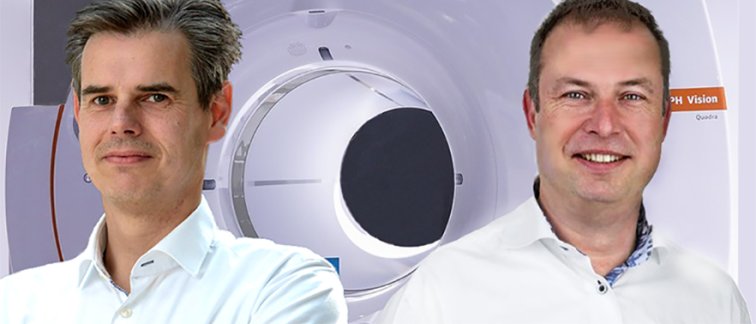Tracer Center Amsterdam, part of the Amsterdam UMC Imaging Center, has an essential role in the development of new tracer molecules that are used in medical imaging for cancer investigation, diagnosis, and targeted therapy. Thanks to support by the ADORE foundation and an investment grant from Cancer Center Amsterdam, the purchase of four 68Ga-generators is set to spur progress in the development and implementation of novel tracer technology.
68Ga is a radioactive isotope that is incorporated into radiolabeled drugs (tracers), substances that are injected into the body and emit small amounts of radiation. These radiopharmaceuticals help visualize various biological processes, such as the presence and spread of cancer cells, to aid in diagnosis and treatment selection.
Over recent years, the use of 68Ga tracers in positron emission tomography (PET) imaging has expanded significantly, offering three-dimensional images with improved localization and quantification of tracer uptake. These advancements have positioned 68Ga-PET imaging as a pivotal tool in the early detection and staging of various cancers, as well as monitoring treatment responses. Beyond its clinical applications, 68Ga-PET imaging hold great potential for bridging the gap between experimental research and bedside application and is anticipated to speed translation of scientific discoveries into care.
Onsite 68Ga Generators
Thanks to support by the ADORE foundation and an investment grant from Cancer Center Amsterdam, the purchase of 4 68Ga-generators was made possible, an initiative by Professors Ronald Boellaard and Bert Windhorst.
These onsite generators will be used to create known gallium tracer molecules in addition to novel gallium tracers to pioneer new therapies, develop breakthrough procedures, and facilitate novel diagnostics.
“This purchase paves the way to application of 68Ga for radiolabeling of oncology PET tracers to be used predominantly in clinical research, but also in preclinical PET,” says Ronald Boellaard, Professor, Radiology and Nuclear Medicine.
Promising Studies Underway
Gallium tracers have some advantages over the commonly used sugar tracer, 18F-FDG: their chemistry allows for easier labelling and the shorter half-life (68 minutes) results in lower radiation burden. “That means we can combine Ga labelled tracers with other tracer studies and stay within radiation dose limits more easily,” explains Prof. Boellaard.
Already, several promising studies are underway at Cancer Center Amsterdam using gallium tracers. (see text box). “Currently we have established the radiolabeling of 68Ga-FAPI-046 (targeting FAP), 68Ga-NOTA-CD206-VHH (nanobody targeting CD206), 68Ga-exendin (peptide targeting GLP1) and are working on the radiolabeling of 68Ga-TUNA (peptide targeting GRRP) as well as 68Ga-pentixafor (peptide targeting the CXCR4),” say Bert Windhorst, Professor of Radiology and nuclear medicine.
Additionally, preclinical studies focusing on immune cell tracking in vivo are investigating ways to develop more effective and personalized therapies against cancer. Already, new tracers for emerging targets - such as immune cell subsets to monitor immune response - are under development at Cancer Center Amsterdam.
Active projects with 68Ga-labelled tracers, made possible by the 68Ga-generator strategic investment grants
PI: Dr. Rutger-Jan Swijnenburg, Departments of Surgery, and Radiology & Nuclear Medicine. Funded by the Dutch Cancer Society (KWF). Disease type: Pancreatic cancer.
PI: Prof. Josee Zijlstra, Departments of Hematology and Radiology & Nuclear Medicine. Funded by Fonds Wetenschappelijk Onderzoek (FWO). Disease type: Multiple Myeloma.
PI: Ben Zwezerijnen, Departments of Oncology and Radiology & Nuclear Medicine. Funded by Cancer Center Amsterdam. Disease type: Breast cancer.
PI: Prof. Geert D’Haens, Departments of IBD (location AMC) and Radiology & Nuclear Medicine. Funded by Helmsley trust. Disease type: Crohn’s disease.
PI: Dr. Pieter Postema, Departments of Cardiology, Radiation Oncology, Radiology & Nuclear Medicine. Funded by Dutch Heart Foundation & EU H2020 project “STOPSTORM”. Disease type: Ventricular tachycardia.
PI: Prof. Conny van der Laken, Departments Rheumatology, Radiology & Nuclear Medicine. 1) Funded by Reuma Nederland. Disease type: Systemic sclerosis. 2) Funded by IMI2 (EU) project Immune-Image. Disease type: Rheumatoid Arthritis.
PI: Dr. Mark Löwenberg, Departments of IBD (location AMC) and Radiology & Nuclear Medicine. Funding information not available. Disease type: Intestinal fibrosis.
The new PET/CT system at work
The new large axial field of view PET/CT system, Biograph Vision Quadra from Siemens Healthineers, has been crucial in revealing essential knowledge about the gallium tracers, including factors such as tumor perfusion, clearance/excretion, and the effect of certain drugs on the behavior of the tracer.
“This knowledge was needed before gallium tracers can be definitively used for both clinical care and further scientific research,” explains Prof. Ronald Boellaard. “With the help of the Siemens Vision Quadra PET/CT system, we were able to accurately and dynamically map this pharmacokinetics and the various factors at the level of the body, organs, and even tumor lesions in a few patients.”
First ‘spin-off’ activity of the strategic investment grants
Currently, there are two projects approved for funding by pharmaceutical companies Boehringer Ingelheim and GSK that will pay for the use of the 68Ga generator. “These projects have been made possible by the knowledge and expertise we gained because of the availability of 68Ga from the generators supported by Cancer Center Amsterdam,” says Prof. Boellaard.
For more information, contact Prof. Ronald Boellaard or Prof. Bert Windhorst.
This article was created for Cancer Center Amsterdam.

